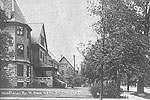|

South Lakefront
(continued)
Many of Kenwood's wealthy residents had businesses in the nearby
stockyards. The neighborhood was conveniently located about three
miles east of the livestock market. While this at first proved
to be a benefit to Kenwood, by the 1920s the odor of the meatpacking
process helped to bring about the decline of the district. Many
of the very rich left the neighborhood for less polluted environs.
As Kenwood changed, the southern portion became more closely
identified with Hyde Park. Faculty members of the University of
Chicago and other professional people began to settle in the area.
In the 1950s and 1960s the two neighborhoods were closely joined
by the urban renewal process and by the fact that their populations
were so similar. Moreover, the neighborhood north of 47th Street
experienced a complete racial turnover and became more closely
associated with the all-black Oakland neighborhood to the north.
South Kenwood, which remained middle class and racially integrated,
tended to identify with Hyde Park.
Hyde Park was a sparsely settled area in the 1830s and 1840s.
Only a few people had ventured into the vicinity. Obadian Hooper,
a farmer, claimed a homestead between 55th and 59th Streets,
between
Woodlawn and Dorchester Avenues,
but he soon lost the land for nonpayment of taxes (See Fig.
1). Dr. William
Egan was also an early settler who purchased a large tract of
land in the area and attempted to build an Irish country estate.
His plans never fully materialized. Earlier, Nathan Wilson constructed
a log cabin at 53rd and the lake and operated a tavern for those
taking the lakefront trail to Chicago. The real estate market,
however, remained dormant until the 1850s.
«
previous
3
of 23
next
»
|
 |

|
 |


Figure 1:
Woodlawn Avenue, looking north from 48th Street, c. 1910. »
|